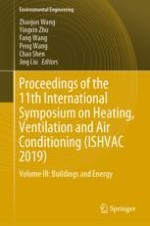2020 | OriginalPaper | Buchkapitel
Effect of Uncertainty in the Hygrothermal Properties on Hygrothermal Modeling
verfasst von : Xiangwei Liu, Ying Liu, Xingguo Guo, Na Luo, Guojie Chen
Erschienen in: Proceedings of the 11th International Symposium on Heating, Ventilation and Air Conditioning (ISHVAC 2019)
Verlag: Springer Singapore
Aktivieren Sie unsere intelligente Suche, um passende Fachinhalte oder Patente zu finden.
Wählen Sie Textabschnitte aus um mit Künstlicher Intelligenz passenden Patente zu finden. powered by
Markieren Sie Textabschnitte, um KI-gestützt weitere passende Inhalte zu finden. powered by
